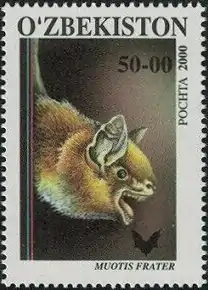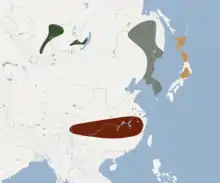Fraternal myotis
The fraternal myotis (Myotis frater) is a species of vesper bat native to East Asia.[2]
| Fraternal myotis | |
|---|---|
 | |
| Scientific classification | |
| Domain: | Eukaryota |
| Kingdom: | Animalia |
| Phylum: | Chordata |
| Class: | Mammalia |
| Order: | Chiroptera |
| Family: | Vespertilionidae |
| Genus: | Myotis |
| Species: | M. frater |
| Binomial name | |
| Myotis frater (G.M. Allen, 1923) | |
 | |
| Fraternal myotis range in red (does not include Taiwan range) | |
Taxonomy
The long-tailed myotis (M. longicaudatus) was split as a distinct species by a 2015 study based on molecular evidence.[3] This has also been followed by the American Society of Mammalogists, the IUCN Red List, and the ITIS.[4][5] Phylogenetic evidence supports the reddish myotis (M. soror) of Taiwan being the sister species to M. frater.[3]
Description
An adult fraternal myotis has a body length of about 5 cm, a tail of about 4.5 cm, and a wing span of about 3.8 cm.[3]
Distribution
The species is found throughout China and Taiwan. Bats that could potentially belong to this species have also been collected in Uttarkhand, India, but their taxonomy remains unresolved.[1]
Status
There are no major threats to this species, although it may be threatened by roadkill in Taiwan. It may be sensitive to climate change, but this was based on the old classification that included M. longicaudatus within the species, and thus this remains unconfirmed.[1]
References
- Notes
- Vincenot, C.E.; Preble, J.H.; Huang, J.C.-C.; Collazo, A.M.; Kamal, A. (2021). "Myotis frater". IUCN Red List of Threatened Species. 2021: e.T85566806A22056940. doi:10.2305/IUCN.UK.2021-2.RLTS.T85566806A22056940.en. Retrieved 19 November 2021.
- "Explore the Database". www.mammaldiversity.org. Retrieved 2022-02-01.
- RUEDI, MANUEL; CSORBA, GÁBOR; LIN, LIANG-KONG; CHOU, CHENG-HAN (2015-02-20). "Molecular phylogeny and morphological revision of Myotis bats (Chiroptera: Vespertilionidae) from Taiwan and adjacent China". Zootaxa. 3920 (2): 301. doi:10.11646/zootaxa.3920.2.6. ISSN 1175-5334.
- "Explore the Database". www.mammaldiversity.org. Retrieved 2022-02-01.
- "ITIS - Report: Myotis longicaudatus". www.itis.gov. Retrieved 2022-02-01.
- Sources
- Won, Byeong-o (원병오) (2004). 한국의 포유동물 (Hangugui poyudongmul, Mammals of Korea). Seoul: Dongbang Media. ISBN 89-8457-310-8.
